The Elusive Pipit
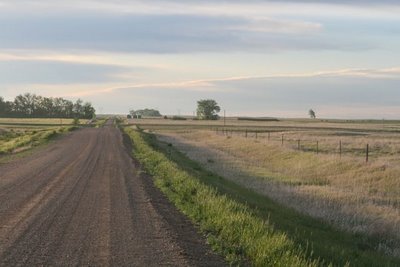
Pipit country at dawn, Kidder County, North Dakota. The pipits live in the prairie to the right side of the road.
I know that many people who read this blog like birds; many of you feed them in the backyard and garden for them just like I do. I'm going to tell you now about a special kind of madness that afflicts a certain cross-section of those who love birds, brought on by a little space in the tickmarks on our checklists. Yes, there are some of us who keep track of the birds we've seen, and the ones we haven't been able to see bother us, sometimes to distraction. The Sprague's pipit is one of those maddening holes for countless birders.
In the United States, only North Dakota, Montana, and a bit of northwestern South Dakota hold Sprague's pipits. They're also found in three prairie provinces of Canada. That's it. You have to go there to see them on the breeding grounds, unless you're lucky enough to catch them wintering in Texas, Mississippi, Lousiana or Nevada. It's well worth going to see them on the breeding grounds, because a singing male will mount high up in the air and sing continuously---seeeuuw, seeuw, seeuw--for an hour or more, even up to three hours of continuous singing and fluttering high above the ground. No other bird on the planet is known to make such a prolonged flight display.
The Sprague's pipit has vanished as the native prairie has disappeared, suffering drastic declines. Introduction of exotic grasses and herbs associated with grazing is the primary cause of their decline. I can attest that you can drive for a long way, even in North Dakota, before you'll find unbroken prairie, often identified by the boulders studding its unplowed contours. Vegetation appears sparse but is very diverse, and it's this diversity that the pipit's insect prey needs. It's all hooked up together: the soil, the rocks, the flora, the insects, and the birds--and the use to which we put the land. Pipits can co-exist with grazing cattle or bison; they need something to keep the vegetation low.
So it was with great anticipation that we loaded into vans at 3:30 AM to see the dawn break on Sprague's pipit country near Tuttle, North Dakota. Our leader was Kim Risen, a Minnesota bird guide who knows Kidder County well. As we climbed out of the vans, a peachy sunrise and low slanting light greeted us, and the Sprague's pipits were already at it, voicing their thin songs high overhead.
It took a lot of doing to get everyone's binoculars focused on the tiny speck high above that would prove to be their life Sprague's pipit. There. In the grayish cloud tier below the whitish-pink one. Now crossing the blue into the left hand grayish cloud...My photos from that morning were largely deletable, until a very cross pipit landed in the road, wanting to know what the heck a pipit was doing singing at waist level from Kim's iPod.
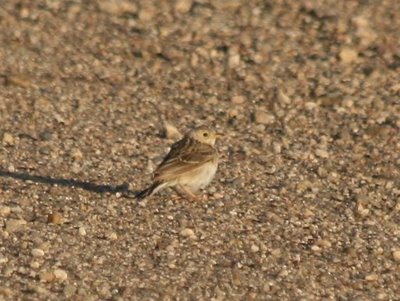
I know. It looks like...nothing. It looks like a little brown bird. But the thin bill means it's a pipit, not a sparrow, and it is rare and treasured among those who know prairie birds. And I'll add that almost nobody gets a shot, even a blurry shot, of a Sprague's pipit on the ground.
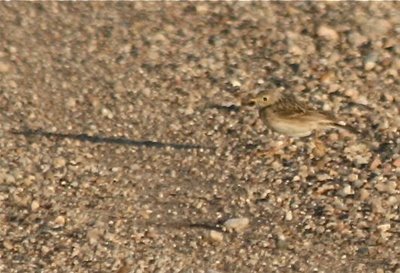
Nothing, chasing its shadow at a dead run.
I loved it, loved the whole experience of greeting the painted dawn on the prairie with a life pipit. Later that morning, we were hunting for Baird's sparrow, another rarity with a similarly limited distribution, when one of our group said, "I almost stepped on a little bird with white outer tail feathers." That got our attention. She pointed to a clump of grass and there huddled a 11-or-12-day-old Sprague's pipit, a priceless diamond, a fledgling of this rare and declining bird.
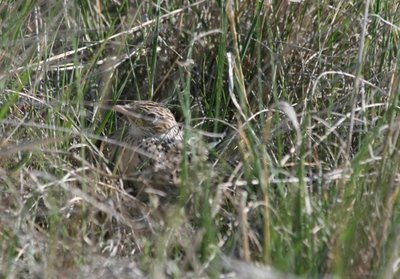 Wow. I know this isn't a great shot, but I wasn't about to go any closer. Overhead, its parents were circling, scolding us, holding insects in their bills. Amazing.
Wow. I know this isn't a great shot, but I wasn't about to go any closer. Overhead, its parents were circling, scolding us, holding insects in their bills. Amazing. 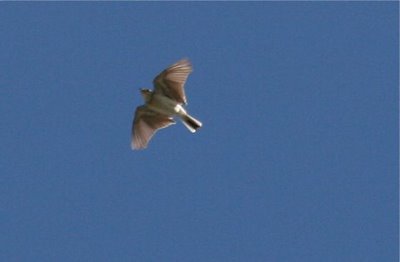
Clearly, it was time to get out of there. I snapped a few more pictures before beating a retreat. In this one, you can see the pipit's eyes turned down right on me.
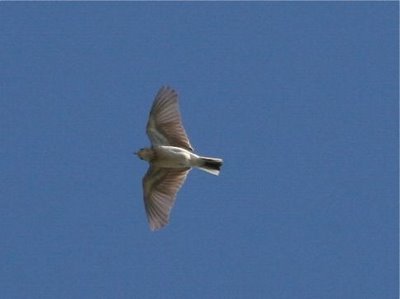 With those great broad wings, it's no wonder a pipit can fly and sing for three hours at a time. We felt honored and not a little abashed to have been right in the pipit's bedroom. May it nest in peace for the rest of the summer, little nothing that means so much.
With those great broad wings, it's no wonder a pipit can fly and sing for three hours at a time. We felt honored and not a little abashed to have been right in the pipit's bedroom. May it nest in peace for the rest of the summer, little nothing that means so much.Labels: Kidder County North Dakota, Sprague's pipit, Sprague's pipit flight song






<< Home